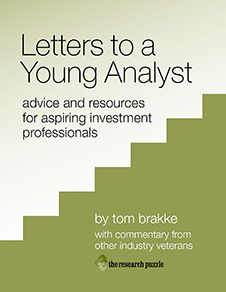
- Tuesday, December 11th, 2012
- perfunctory risks
-
I have risk management on my mind.
Meeting with a client recently on risk management issues, I said that “risk management is forward-looking and creative, not backward-looking and statistical.” The latter has its place and can inform the former, but that standard approach often ends up strangling risk management rather than energizing it.
Then I heard that a major investment firm had gutted its risk management function because a change in regulators for it meant fewer hoops to jump through and therefore some costs to be saved.
Today I saw a list of “top fears” of institutional investors for the coming year;aiCIO | This site is a good source of information about the institutional world. you can assume that they’ll be the main focus of stress tests, scenario analyses, and other risk management processes for those investors. However, it’s just as likely that “risk,” however you define it, will show up in a different corner altogether.
It might not seem an easy transition from these “macro” examples to the next posting in a series on equity researchthe research puzzle | This PDF is updated as new postings in the series are produced. but the same principles apply in equity analysis too — and the same behavioral tendencies trip us up.
We like to fight the last war, since its lessons are fresh in our minds. We gravitate toward risks that are well identified, be they for the global economy or a stock, since we will undoubtedly be asked about them by clients and co-workers, and it is nice to have thoughtful answers. Even having identified them, however, we aren’t very good about evaluating them and talking about them in concrete ways rather than as generalized concerns.
Consider two places where a list of risks for a stock would be found. An IPO prospectus features a kitchen-sink approach, listing everything possible to avoid legal issues later on. Reading the list, it is easy to think, “yeah, yeah, yeah,” and not pay much attention to the risks.
In contrast to that, most buy-side and sell-side reports have remarkably brief expositions of relevant risks, duly filtered and narrowed and in concert with the analyst’s thesis. As an exercise, take the last ten blow-ups in your sphere of analysis and see how many times the catalyst for the decline had been identified and examined in advance in the reports produced by leading analysts. (Don’t count binary events like an FDA approval.)
It is often something seemingly out of the blue that gets you, but is that really the case? We ask analysts to perform a wide range of functionsthe research puzzle | This piece about “those darn analysts” looks at that range of duties. and to consider an amazing array of inputs. It is no surprise that it all gets boiled down in a hurry to a few key factors, typically those that are dominating the conversation among analysts, portfolio managers, clients, and even the media.
Often left out of the discussion are topics like accounting risk (analysts go with the flow more than make waves regarding questionable accounting treatments), governance risk, and guidance risk. Among other types of overlooked risks, they show up disproportionally versus the amount of time spent on them by analysts. In practice, they are perfunctory risks; in actuality they are potentially significant ones.
For an investment organization, trying to effectively communicate about the risk of an idea is not easy. Analysts become advocates for their ideas, not educators about the risks inherent in them, or even very good judges of those risks. Little if any time is allocated to original research aimed at identifying risks unseen (or improperly assessed) by others.
In a world of sameness when it comes to the process of analysis, here is an area where differentiation is possible but difficult. Those searching for alpha should welcome the challenge.
